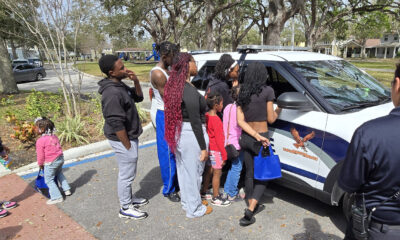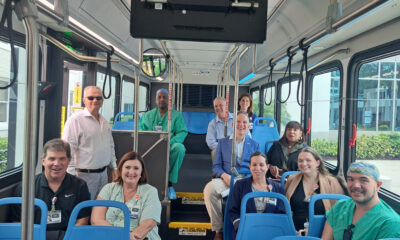Thrive
‘Unicorn’ affordable housing project progresses in St. Pete

Jeff Brandes has an extensive emotional attachment to a long-planned affordable housing project in South St. Petersburg that is now moving forward.
The former senator’s family opened a lumber yard on the expansive site at 3300 Fairfield Ave. S. in the 1970s. While Brandes was always a part of the development team, he officially purchased the seven-acre property in mid-October.
He expects demolition to begin within the next 30 days. The Fairfield Apartments will provide 264 affordable and workforce housing units once complete.
“This is kind of a unicorn of a site,” Brandes told the Catalyst. “It’s seven acres along U.S. 19, the Pinellas Trail and next to Gibbs High School. You can be downtown in five to eight minutes.
“It’s a fantastic site for individuals who work downtown and don’t want to pay downtown rents.”
In April 2022, St. Petersburg became Florida’s first city to approve a project – the Fairfield Apartments – under House Bill 1339. The 2021 legislation, a precursor to the Live Local Act, allowed local governments to create affordable housing in industrially zoned areas.
The project site near the Warehouse Arts District once housed the original Tibbets Lumber, founded by Linton Tibbetts, Brandes’ grandfather. The company has since relocated to Clearwater.
Brandes said crews are now removing asbestos and preparing the building for demolition. He expects to break ground in February or March.
“When my family decided to sell it, I told them I wanted to buy it,” Brandes said. “I didn’t have the cash right away to close on the deal, so I had a third party buy it. I basically had lease rights with an understanding that we would purchase the property in a year.”
While the process took longer than expected, Brandes recently purchased the site for $6.18 million from a company linked to local investor Tom Gaffney, according to a Pinellas County deed. Property records show the buyer took out a $3.5 million mortgage to help facilitate the purchase.
St. Petersburg-based HP Capital will oversee development, and Kast Construction is the general contractor. The city allocated $2.28 million in American Rescue Plan Act funding to the project in August 2022.

The Fairfield Apartments will dedicate 53 homes to households earning less than 50% of the area median income.
Post-pandemic construction costs continued soaring, and Pinellas County Commissioners more than doubled their initial investment, from $5.6 million to $12.4 million, in November 2023. The city council increased its commitment to $9.7 million later that month.
At the time, Councilmember Brandi Gabbard credited the development team for not decreasing the number of units or increasing income limits. “I think we’re really fortunate with this project,” Gabbard said. “I want more projects like this.”
The Fairfield Apartments will allocate 53 homes for households earning less than 50% of the area median income (AMI) – currently $33,540 for one person. Another 67 units are those making below 80% of the AMI, and the remaining 144 apartments are for households earning less than 120%.
Brandes noted the county would own the land and place it in a trust, ensuring a 99-year affordability term. “We’re moving towards closing,” he said.
Brandes said his grandfather “spent his entire life” helping build St. Petersburg. “I think he’d be honored to know somebody’s living there on that property, and we’ve continued to keep that in the family.”
The former state senator has long advocated for regulatory changes that support affordable housing. Brandes has continued that mission since founding the Florida Policy Project (FPP), a St. Petersburg-based think tank.
“It’s one thing to talk about it theoretically,” he said of affordable housing. “It’s another thing to put it into practice.”
Brandes now has firsthand experience with policies that support affordable housing development or hinder projects. “I think it helps me advise my colleagues in the legislature on how to improve the system,” he explained.
“In our first series of reports, we (FPP) laid out the strategies the legislature needs to implement – if they want to see housing costs come down at scale,” Brandes added. “Frankly, it’s up to the state to lead, but then it’s up to the cities and counties to adopt.”








Peter
November 19, 2024at5:02 pm
the city has money to give away but no money to fix sewage, storm water issues so add more traffic more usage of sewers and never have money to fix the issues wow
Emma baynard
November 16, 2024at1:37 pm
How do you apply for this affordable housing unit on fairfield
Mike
November 16, 2024at12:29 pm
Please explain how this qualifies as an “investment” by the county. From the article, it seems like the county will never see a dime of that money again. Thats not what an “investment” is. Thats misallocation of public funds.
And stop calling it “affordable” housing. Its a loaded political term that misrepresents the funding structure in order to steal and launder public money. Thats our money getting stolen and thrown away.
S. Rose Smith-Hayes
November 16, 2024at9:09 am
I do hope that there will be spots for hourly employees to live. they are the ones being displaced by high rents. $12.00 hr does not provide much to pay costs of living when a one bedroom rents for $1800 a month.
Hugh Hazeltine
November 16, 2024at9:02 am
In 2024, several bills revising the Live Local Act were signed into law. The Act is intended to address the state’s growing housing affordability crisis through significant land use, zoning, and tax benefits.
Hugh Hazeltine
November 16, 2024at8:59 am
The American Rescue Plan Act of 2021, also called the COVID-19 Stimulus Package or American Rescue Plan, is a US$1.9 trillion economic stimulus bill passed by the 117th United States Congress and signed into law by President Joe Biden on March 11, 2021, to speed up the country’s recovery from the economic and health effects of the COVID-19 pandemic and recession.